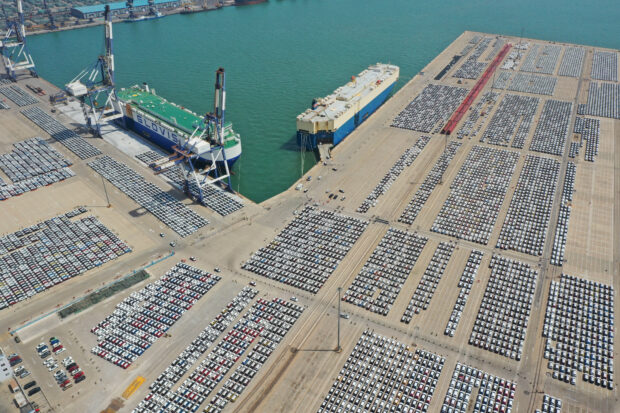China’s Jan-Feb imports and exports beat forecasts

An aerial view shows cars for export at a port in Yantai, Shandong province, China May 3, 2023. China Daily via REUTERS/File photo
BEIJING — China’s export and import growth in the January-February period beat forecasts, suggesting global trade is turning a corner in an encouraging signal for policymakers as they try to shore up a stuttering economic recovery.
China’s improved export data joins those of South Korea and Germany, and Taiwan, who all saw their shipments top expectations over the first two months of the year, with the Asian economies benefiting from a surge in demand for semiconductors.
Exports from the world’s second-biggest economy in the two months were 7.1 percent higher than a year before, customs data showed on Thursday, beating a Reuters a poll that expected an increase of 1.9 percent. Imports were up 3.5 percent, compared with a poll forecast for growth of 1.5 percent.
“The better-than-forecast data echoes a recovery in global trade driven by the electronics sector, but also benefits from a low base effect, as export growth in January-February 2023 was -6.8 percent,” said Xu Tianchen, senior economist at the Economist Intelligence Unit.
READ: READ: China’s Q4 GDP shows patchy economic recovery, raises case for stimulus
The customs agency publishes combined January and February trade data to smooth out distortions caused by the shifting timing of the Lunar New Year, which this year fell in February.
Sustained rebound needed
Chinese Premier Li Qiang on Tuesday announced a 2024 economic growth target similar to last year of around 5 percent and promised to transform the country’s development model, which is heavily reliant on exporting finished goods and industrial overcapacity.
READ: China sets ambitious 5% growth target for 2024
Policymakers have been grappling with sub-par growth over the past year amid a property crisis and as consumers hold off spending, foreign firms divest, manufacturers struggle for buyers, and local governments contend with huge debt burdens.
Policymakers will need to see a sustained rebound in exports to be convinced that the crucial engine of growth will help bolster the economy.
In contrast to the trade data, for instance, manufacturing activity in China in February shrank for a fifth month, according to the government’s purchasing managers’ index released a week ago, while new export orders decreased for an 11th consecutive month.
“After accounting for changes in export prices and for seasonality, we estimate that export volumes rose significantly in January and February, hitting a fresh high,” said Zichun Huang, China economist at Capital Economics, in a note.
“We doubt the sustainability of this strength, however, since exporters now have more limited scope to reduce prices to secure market share,” she added.
Cause for optimism
Some cause for optimism can be found in the fact China’s exports to the United States in January-February returned to growth, rising 5 percent from a year earlier compared with a decline of 6.9 percent in December. But outbound shipments to EU still shrank 1.3 percent in the same period.
Policymakers have pledged to roll out further measures to help shore up growth after the steps implemented since June had only a modest effect, but analysts caution Beijing’s fiscal capacity is now very limited and note Li’s address to the annual meeting of the National People’s Congress also failed to inspire investor confidence.
READ: China’s parliament to unveil more stimulus this week
Many analysts worry that China may begin flirting with Japan-style stagnation later this decade unless policymakers take steps to reorient the economy towards household consumption and market-allocation of resources.
China’s trade surplus grew to $125.16 billion, compared with a forecast of $103.7 billion in the poll and $75.3 billion in December.